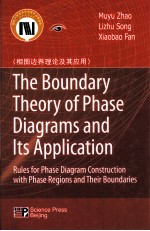图书介绍
相图边界理论及其应用 英文版PDF|Epub|txt|kindle电子书版本网盘下载

- 赵慕愚著 著
- 出版社: 北京:科学出版社
- ISBN:9787030244581
- 出版时间:2009
- 标注页数:238页
- 文件大小:10MB
- 文件页数:253页
- 主题词:相图-研究-英文
PDF下载
下载说明
相图边界理论及其应用 英文版PDF格式电子书版下载
下载的文件为RAR压缩包。需要使用解压软件进行解压得到PDF格式图书。建议使用BT下载工具Free Download Manager进行下载,简称FDM(免费,没有广告,支持多平台)。本站资源全部打包为BT种子。所以需要使用专业的BT下载软件进行下载。如BitComet qBittorrent uTorrent等BT下载工具。迅雷目前由于本站不是热门资源。不推荐使用!后期资源热门了。安装了迅雷也可以迅雷进行下载!
(文件页数 要大于 标注页数,上中下等多册电子书除外)
注意:本站所有压缩包均有解压码: 点击下载压缩包解压工具
图书目录
Part One The Phase Rule,Its Deduction and Application3
Chapter 1 The Phase Rule,Its Deduction and Application3
1.1 Why do We Discuss the Phase Rule at First3
1.2 Different Methods for Deducing the Phase Rule:The Method of Gibbs Himself,Gibbs-Roozeboom's Method and the Method of Gibbs Free Energy Minimization4
1.3 Determination of the Number of Independent Components by Brink-ley's Method14
1.4 Some Remarks on the Application of the Phase Rule25
References-128
Summary of Part One28
Part Two The Boundary Theory of Isobaric Phase Diagrams and Its Application31
Chapter 2 The Boundary Theory of Isobaric Phase Diagrams—Rules for Phase Diagram Construction31
2.1 Introduction31
2.2 Several Basic Concepts for Underlying the Phase Diagram32
2.3 The Theorem of the Corresponding Relationship between the Total Nu-mber of All the Different Phases in NPRs Ф and the Dimensions of the Phase Boundary R1 in Phase Diagrams,and Its Theoretical Deduction38
2.4 The Theorem of the Corresponding Relationship(TCR)is an Indepen-dent Theorem,Not a Variant of the Phase Rule41
2.5 Corollaries of TCR for Isobaric Phase Diagrams44
2.6 The Relationship between the Dimensions of the Phase Boundary R1 and the Dimensions of the Boundary Rí for Isobaric Multiconponent Phase Diagrams48
2.7 The Summary of the Boundary Theory of Isobaric Phase Diagrams4858
References-259
Chapter 3 Application of the Boundary Theory to Unary,Binary and Ternary Phase Diagrams61
Comparison of the Boundary Theory Application and Palatnik-Landau's Contact Rule of Phase Regions61
3.1 Determination of Phase Assemblages of NPRs and the Characteristics of Their Boundaries by the Boundary Theory61
3.2 Application of the Boundary Theory to Unary Phase Diagrams63
3.3 Application of the Boundary Theory to Binary Phase Diagrams64
3.4 Application of the Boundary Theory to Ternary Phase Diagrams68
3.5 Explanation of Rhines'Ten Empirical Rules for Constructing Complicated Ternary Phase Diagrams with the Bounary Theory82
3.6 Comparison of the Boundary Theory and the P-L's Contact Rule of Phase Regions85
References-391
Chapter 4 The Application of the Boundary Theory of Phase Diag-rams to the Quaternary and Higher Number Component Phase Diagrams92
4.1 Introduction92
4.2 The Relationship among NPRs and their Boundaries in a Typical,Iso-baric,Quaternary Phase Diagram92
4.3 During Temperature Decreasing,Some Cases of Variations of the NPRs and their Boundaries,May be Encountered for Several Types of Quaternary Isobaric Phase Diagrams94
4.4 The Isobaric Quinary Phase Diagrams106
4.5 Conclusion106
References-4106
Chapter 5 The Boundary Theory in Construction of Multicompo-nent Isothermal Sections107
5.1 The Relationship among Neighboring Phase Regions(NPRs)and Th-eir Boundaries in Isobaric Isothermal Multicomponent Sections107
5.2 The Non-Contact Phase Regions and the Boundaries between Them110
5.3 Construction of an Isothermal Quinary Section,with Limited Information112
5.4 The Method of Constructing an Isothermal Eight-Component Section116
5.5 Summary of Using the Boundary Theory Method121
References-5121
Chapter 6 The Boundary Theory of Multicomponent Isobaric Isopleth Sections122
6.1 Introduction122
6.2 The Characteristics of Boundaries in Isopleth Sections for the Case of N≥2 and R1≥1123
6.3 The Characteristics of Boundaries in the Isopleth Section for the Case of N≥2,R1=0,there is no Invariant Phase Transition between the two NPRs126
6.4 The Case of N≥2,R1=0,there is an Invariant Phase Transition between the two NPRs.In this Case,there may be a Boundary Line or a Boundary Point between two NPRs127
6.5 Example129
6.6 The Theory of Two-Dimensional Sections of Isobaric Multicomponent Phase Diagrams132
References-6134
Chapter 7 The Application of the Boundary Theory to Isobaric Phase Diagrams135
7.1 Brief Review of the Application for the Boundary Theory135
7.2 The Analysis of the Fe-Cr-C Isopleth Section135
7.3 The Application of the Boundary Theory to Phase Diagram Calculation138
7.4 The Application of the Boundary Theory to Phase Diagram Assessment145
7.5 The Application of the Boundary Theory to Phase Diagram Determination149
7.6 The Application of the Boundary Theory to Phase Diagram Education152
References-7152
Summary of Part Two153
Part Three The Boundary Theory and Calculation of High Pressure Phase Diagrams157
Chapter 8 The Boundary Theory for p--T-xi Multicomponent Phase Diagrams157
8.1 Introduction157
8.2 The Theorem of Corresponding Relationship for p-T-xi Multicomponent Phase Diagrams and Its Corollaries158
8.3 The Relationship between Rí and R1 in p-T-xi Multicomponent Phase Diagrams160
8.4 The Relationship among NPRs and Their Boundaries for the p-T-x Binary Phase Diagrams167
8.5 Relationship among NPRs and their Boundaries for the p-T-xi Ternary Phase Diagram168
8.6 The Application of Boundary Theory for Quaternary p-T-xi Phase Diagrams170
8.7 The Reliability of the Boundary Theory of Multicomponent p-T-xi Phase Diagrams171
References-8171
Chapter 9 The Calculation of Unary High-Pressure Phase Diagra-ms and the Boundary Theory of p-T Phase Diagrams of Multicomponent Systems173
9.1 Introduction173
9.2 Calculation of Uuary p-T Diagrams174
9.3 The Boundary Theory of p-T Phase Diagrams of Multiconponent Systems without Composition Variable176
Referenees-9177
Chapter 10 Calculation of Binary High-Pressure Phase Diagrams178
10.1 Principles for the Calculation of Binary Phase Diagrams at Elevated Pressures178
10.2 Calculation of the Standard Molar Gibbs Free Energy for the Pure Components180
10.3 Calculation of Activity Coefficients γi(T,p0,xi)of the i-th Component in the Equilibrium Phases181
10.4 Partial Molar Volumes183
10.5 Some Remarks on the Values of α andβ186
10.6 Example-Calculation of the Cd-Pb Phase Diagram at High Pressure187
References-10194
Chapter 11 The Calculation of High-Pressure Ternary Phase Dia-grams196
11.1 The Characteristics of the Boundaries of the High-Pressure Ternary Phase Diagrams,and the Basic Equations for Their Calculation196
11.2 The Treatment of Thermodynamic Parameters for Ternary Systems at High Pressure201
11.3 Verification of the Estimation Method for the Excess Molar Volume by Experiment204
11.4 The Calculation of High-Pressure Phase Diagrams of Cd-Pb-Sn and Cd-Sn-Zn Systems206
11.5 Verification of Calculated High-Pressure Ternary Phase Diagrams through Experimental Determination219
11.6 The Comparison between the Methods of Experimental Determina-tion and Thermodynamic Calculation of High Pressure Phase Diagrams221
References-11223
Summary of Part Three224
References of This Book226
Important Symbols230
Index232
Annex234